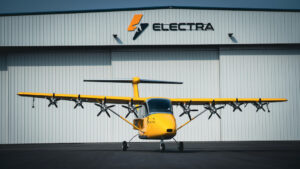Starting small, Electra Aero has rolled out a two-seat demonstrator of its multi-motor, blown-lift technology. Bright yellow, the EL-2 “Goldfinch” celebrates “the beloved, nimble American Goldfinch bird indigenous to North America,” according to the company. Its full-scale production aircraft will carry nine.
John S. Langford, Founder and CEO of Electra.aero explains, “In the three years since we founded Electra, we’ve designed our eSTOL aircraft, validated our blown lift technology with a sub-scale demonstrator, and run a fully integrated test of our 150-kilowatt hybrid-electric generator at full scale. Now we’re ready to test the entire system with this technology demonstrator aircraft. We can’t wait to fly this plane and show the world what our eSTOL aircraft can do.”
Chris Courtin, Chief Engineer on the technology demonstrator project, explains the ambitious aircraft, a two-seat version of which will fly this year.
Electra notes its “proprietary blown lift technology uses eight motors to provide additional wing lift, and hybrid-electric power that provides internal recharging capabilities for aircraft batteries, eliminating the need for new ground infrastructure.” This self-sufficiency should be a selling point for small regional airports, where regular delivery of passengers and goods would open new opportunities for rural communities.
The technology demonstrator is nearing flight tests soon, and Vice President J. P. Stewart gives a brief preview of what’s coming. (Click anyway – the video will play)
The two inner motors on each wing are larger diameter than the outer two, showing some clever design touches that we hope will be spelled out in further releases. Adjoining propellers also spin counter to one another, reducing torque reactions on each wing. One can glimpse this in a truck-borne exercise that shows smooth airflow over the wing.
Emulating Burt Rutan’s early rolling wind tunnels and the X-57 project’s HEIST semi-truck platform, the Electra team eases toward its goals.
Stewart lists the advantages of distributed electric propulsion (DEP) and the blown wing.
“This DEP-enabled blown lift lets us increase the lift coefficient of the wing roughly three to four times that of traditional aircraft. In effect, it makes the wing much bigger aerodynamically than it is physically. That lets you take off and land at very low speeds around 30 knots, [35mph, 55km/s]. You can then take off and land at very short distances with comfortable accelerations akin to a car at a stop sign.”
A history of Accomplishments
Langford and fellow student Mark Drela (now an advisor for Electra) designed, built, and successfully oversaw the flight of the Daedalus human-powered aircraft in 1988, completing a 74-mile trip across the Sea of Crete. Their creation was ultralight in the extreme: “The five piece, 112ft mainspar, stressed to 2G, weighs only nineteen pounds – and the entire fuselage structure, which is 26ft long and 6ft high, tips the scales at just 51b.14oz!”
Since then, Langford let Aurora Flight Sciences and started Electra.aero, each time demonstrating new technologies and advanced thinking in aerodynamics.

Electra’s eSTOL technology demonstrator is the world’s first blown lift aircraft using distributed electric propulsion, which enables the airplane to take off and land in very short spaces. (Image: Electra)
Electra.aero has revealed its first full-size aircraft this month, a two-seat demonstrator to validate the company’s innovative short take-off and landing technology. Using the wing from a Cessna 172, the craft will have, to some extent, a means to test the blown wing against its more conventional cousin. The team has tested its 150kW hybrid-electric propulsion system on an “iron bird.”

Electra Aero’s iron bird test stand will ensure reliability before flying the Goldfinch test vehicle. Image: Electra Aero
With a completed airframe, “The team is currently integrating and testing systems in preparation for its maiden flight.” J. P. Stewart explains, “The original concept was to start with a Cessna 172 as the basis for the whole airframe to reduce cost, but early in design it became clear that the systems integration favored a clean-sheet design.”
A Strong Customer Base
Anticipating the DEP/blown wing aircraft will meet their needs, over 30 customers have come forward with deposits in hand.
Aerospace America, an AIAA publication reports, “Electra’s technology development is being funded in part by NASA and the U.S. Air Force Agility Prime program. Electra says it has 1,200 preorders for the nine-seater. A prototype of the nine-seat production aircraft is slated to be built by 2025.”
Your editor can hardly wait for a ride.

